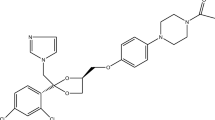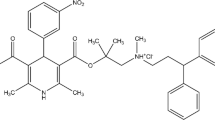Abstract
Tolterodine tartrate (TOTA) is associated with adverse effect, high hepatic access, varied bioavailability, slight aqueous solubility, and short half-life after oral delivery. Hansen solubility parameters (HSP, HSPiP program), experimental solubility (T = 298.2 to 318.2 K and p = 0.1 MPa), computational (vanʼt Hoff and Apelblat models), and thermodynamic models were used to the select solvent(s). HSPiP predicted PEG400 as the most suitable co-solvent based on HSP values (δd = 17.88, δp = 4.0, and δh = 8.8 of PEG400) and comparable to the drug (δd = 17.6, δp = 2.4, and δh = 4.6 of TOTA). The experimental mole fraction solubility of TOTA was maximum (xe = 0.0852) in PEG400 confirming the best fit of the prediction. The observed highest solubility was attributed to the δp and δh interacting forces. The activity coefficient (ϒi) was found to be increased with temperature. The higher values of r2 (linear regression coefficient) and low RMSD (root mean square deviation) indicated a good correlation between the generated “xe” data for crystalline TOTA and the explored models (modified Apelblat and vanʼt Hoff models). TOTA solubility in “PEG400 + water mixture” was endothermic and entropy-driven. IR (immediate release product) formulation can be tailored using 60% PEG400 in buffer solution for 2 mg of TOTA in 0.25 mL (dosing volume). The isotonic binary solution was associated with a pH of 7.2 suitable for sub-Q delivery. The approach would be a promising alternative with ease of delivery to children and aged patients.
Graphical Abstract




Similar content being viewed by others
References
Shaik RP, Puttagunta SB, Kothapalli CB, Awen BZS, Challa BR. A validated LC–MS/MS method for the determination of tolterodine and its metabolite in rat plasma and application to pharmacokinetic study. Journal of Pharmaceutical Analysis. 2013;3(6):489–99.
Librach SL. Chapter 13: Urinary incontinence. Palliative Care. 2011;176–185. https://doi.org/10.1016/b978-1-4377-1619-1.00013-5.
Maggiore ULR, Salvatore U, Alessandri S, Remorgida F, Origoni V, Candiani M, Venturini M, Ferrero PLS. Pharmacokinetics and toxicity of antimuscarinic drugs for overactive bladder treatment in females. Expert Opin Drug Metab Toxicol. 2012;8(11):1387–408.
Jones LH, Randall A, Napier C, Trevethick M, Sreckovic S, Watson J. Design and synthesis of a fluorescent muscarinic antagonist. Bioorg Med Chem Lett. 2008;18(2):825–7.
Brynne N, Stahl MM, Hallen B, Edlund PO, Palmér L, Höglund P, Gabrielsson J. Pharmacokinetics and pharmacodynamics of tolterodine in man: a new drug for the treatment of urinary bladder overactivity. Int J Clin Pharmacol Ther. 1997;35:287–95.
Byeon JY, Kim YH, Kim SH, Lee CM, Choi CI, Bae JW, Jang CG, Lee SY, Lee YJ. Inhibition of salivary secretion by tolterodine transdermal patch. Arch Pharm Res. 2017;40:1455–63.
Elshafeey AH, Kamel AO, Fathallah MM. Utility of nanosized microemulsion for transdermal delivery of tolterodine tartrate: ex-vivo permeation and in-vivo pharmacokinetic studies. Pharm Res. 2009;26(11):2446–53.
Kitak T, Dumicic A, Planinsek O, Sibanc R, Srcic S. Determination of solubility 10 parameters of ibuprofen and ibuprofen lysinate. Molecules. 2015;20:21549–68.
Hansen CM. Hansen solubility parameters: a user’s handbook. 2nd ed. CRC Press. 2007. https://doi.org/10.1201/9781420006834.
Basu N, Chakraborty A, Ghosh R. Carbohydrate derived organogelators and the corresponding functional gels developed in recent time. Gels. 2018;4(2):52. https://doi.org/10.3390/gels4020052.
Kumar CB, Narayanan BL, Chandrasekar M, Malairajan P, Kumar EP. Development and validation of RP-HPLC method for the quantitative estimation of tolterodine tartrate in capsule formulation. RGUHS J Pharm Sci. 2013;3(3):58–64.
Taymouri S, Mostafavi A, Talabaki H. Formulation and evaluation of taste-masked oral disintegrating tablet containing tolterodine-loaded montmorillonite. Research in Pharmaceutical Sciences. 2023;18(5):528–40.
Hussain A, Alshehri S, Ramzan M, Afzal O, Altamimi ASA, Alossaimi MA. Biocompatible solvent selection based on thermodynamic and computational solubility models, in-silico GastroPlus prediction, and cellular studies of ketoconazole for subcutaneous delivery. Journal of Drug Delivery Science and Technology. 2021;65: 102699. https://doi.org/10.1016/j.jddst.2021.102699.
Soltanpour S, Nazemi V. Solubility of ketoconazole in binary and ternary solvents of polyethylene glycols 200, 400 or 600 with ethanol and water at 298.2 K. Data Report and Analysis. J Solution Chem. 2018;47:65–79.
Prakash L, Himaja M, Vasudev R. Isolation, identification, and characterisation of degradation products and the development and validation of a stability-indicating method for the estimation of impurities in the tolterodine tartrate formulation. Sci Pharm. 2014;83(1):65–83.
Burke CMJ. Solubility parameters: theory and applications. AIC Book and Paper Group Annual. 1984;3:13–58.
Hildebrand JH, Scott RL. The solubility of nonelectrolytes. New York: Reinhold Pub. Corp.; 1950. pp. 514.
Van Krevelen DW. Properties of polymers: their correlation with chemical structure; their numerical estimation and prediction from additive group contributions. Amsterdam: Elsevier; 2009. pp. 956–1004.
Ruidiaz MMA, Rodríguez DSJ, Neita RPC, Cristancho BDM, Martínez RM. Performance of the Jouyban-Acree Model for correlating the solubility of indomethacin and ethylhexyl triazone in ethyl acetate + ethanol mixtures. Vitae, Revista de La Facultad de Química Farmacéutica. 2010;17(3):2145–660.
Apelblat A, Manzurola E. Solubilities of o-acetylsalicylic, 4-aminosalicylic, 3,5-dinitrosalicylic and p-toluic acid and magnesium-DL-aspartate in water from T = 20 (278–348) K. J Chem Thermodyn. 1999;31:85–91.
Manzurola E, Apelblat A. Solubilities of L-glutamic acid, 3-nitrobenzoic acid, acetylsalicylic, p-toluic acid, calcium-L-lactate, calcium gluconate, magnesium-DL- aspartate, and magnesium-L-lactate in water. J Chem Thermodyn. 2002;34:1127–36.
Yu S, Xu X, Xing W, Xue F, Cheng Y. Solubility, thermodynamic parameters, and dissolution properties of gliclazide in seventeen pure solvents at temperatures from 278.15 to 318.15 K. Journal of Molecular Liquids. 2020;312:113425. https://doi.org/10.1016/j.molliq.2020.113425.
Bhesaniya KD, Chavda KV, Sadhu CH, Baluja S. Thermodynamic characteristics of solutions of ornidazole in different organic solvents at different temperatures. J Mol Liq. 2014;191:124–7.
Jim M, Kim K-J. Solubility of forms I and II of clopidogrel hydrogen sulfate in formic acid, N-methylpyrrolidone, and N, N-dimethylformamide. J Chem Eng Data. 2012;57(2):598–602.
Krug RR, Hunter WG, Grieger RS. Enthalpy-entropy compensation. 2. Separation 5 of the chemical from the statistic effect. J Phys Chem. 1976;80:2341–51.
Shen Y, Liu W, Bao Z. Solubility measurement and thermodynamic modeling of doxycycline hyclate two binary solvent systems at 276.95–323.75K. J Mol Liq. 2019;289:111138.
Reddy MB, Bolger MB, Fraczkiewicz G, Del Frari L, Luo L, Lukacova V, Mitra A, Macwan JS, Mullin JM, Parrott N, Heikkinen AT. PBPK modeling as a tool for predicting and understanding intestinal metabolism of uridine 5’-diphospho-glucuronosyltransferase substrates. Pharmaceutics. 2021;13(9):1325. https://doi.org/10.3390/pharmaceutics13091325.
Kim J, Gao Y, Zhao Z, Rodrigues D, Tanner EEL, Ibsen K, Sasmal PK, Jaladi R, Alikunju S, Mitragotri S. A deep eutectic-based, self-emulsifying subcutaneous depot system for apomorphine therapy in Parkinson’s disease. PNAS. 2022;119(9): e2110450119.
Al-Shdefat R. Solubility determination and solution thermodynamics of olmesartan medoxomil in (PEG-400 + water) cosolvent mixtures. Drug Dev Ind Pharm. 2020;46(12):2098–104.
Dibrov G, Kagramanov G, Sudin V, Molchanov S, Grushevenko E, Yushkin A, Volkov V. Influence of draw ratio and take-up velocity on properties of ultrafiltration hollow fiber membranes from polyethersulfone. Fibers. 2022;10:29. https://doi.org/10.3390/fib10030029.
Jankovic S, Tsakiridou G, Ditzinger F, Koehl NJ, Price DJ, Ilie A-R, Kalantzi L, Kimpe K, Holm R, Nair A, Griffin B, Saal C, Kuentz M. Application of the solubility parameter concept to assist with oral delivery of poorly water-soluble drugs - a PEARRL review. J Pharm Pharmacol. 2019;71(4):441–63.
Gade R, Nama S, Avula P. Formulation development and evaluation of modified oral drug delivery system of tolterodine tartrate microsponges. J Res Pharm. 2022;26(5):1138–55.
Reddy BP, Reddy KR, Reddy RR, Reddy DM, Reddy KSC. Polymorphs of tolterodine tartrate. United States Patent, US 7,393,874B2; 2008. pp. 1–4.
Johnson EJ, Duan JE, Srirattana K, Venkitanarayanan K, Tulman ER, Tian XC. Effects of intramuscularly injected plant-derived antimicrobials in the mouse model. Sci Rep. 2022;12(1):5937. https://doi.org/10.1038/s41598-022-09705-9.
Hussain A, Altamimi MA, Afzal O, Altamimi ASA, Ali A, Ali A, Martinez F, Siddique MUM, Acree WE Jr, Jouyban A. Preferential solvation study of the synthesized aldose reductase inhibitor (SE415) in the PEG 400 (1) + water (2) cosolvent mixture and GastroPlus-based prediction. ACS Omega. 2022;7(1):1197–210.
Grepioni F, Braga D, Chelazzi L, Shemchuk O, Maffei P, Sforzini A, Viscomi GC. Improving solubility and storage stability of rifaximin via solid-state solvation with transcutol®. CrystEngComm. 2019;21:5278–83.
Paik D, Lee H, Kim H, Choi J-M. Thermodynamics of π–π interactions of benzene and phenol in water. Int J Mol Sci. 2022;23:9811. https://doi.org/10.3390/ijms23179811.
Etman MA, Nada AH. Hydrotropic and cosolvent solubilisation of indomethacin. Acta Pharm. 1999;49(4):291–8.
Liu L, Li H, Chen D, Zhou X, Huang Q, Yang H. Solubility of 1,1-diamino-2,2-dinitroethylene in different pure solvents and binary mixtures (dimethyl sulfoxide + water) and (N, N-dimethylformamide + water) at different temperatures. Fluid Phase Equilibria. 2018;460:95–104.
Acknowledgements
The authors extend their appreciation to King Saud University for funding this work through research supporting project (RSP2024R376), Riyadh, Saudi Arabia.
Funding
The authors received funding from the King Saud University through research supporting project (RSP2024R376), Riyadh, Saudi Arabia.
Author information
Authors and Affiliations
Contributions
AM: conceptualization, funding acquisition, and methodology, TK: writing, review, and editing, and software, MUMS: validation, analysis, and methodology, AF: review and editing, AKS: software and data analysis, ZRB: editing and review.
Corresponding author
Ethics declarations
Conflict of Interest
The authors declare no competing interests.
Additional information
Publisher's Note
Springer Nature remains neutral with regard to jurisdictional claims in published maps and institutional affiliations.
Supplementary Information
Below is the link to the electronic supplementary material.
Rights and permissions
Springer Nature or its licensor (e.g. a society or other partner) holds exclusive rights to this article under a publishing agreement with the author(s) or other rightsholder(s); author self-archiving of the accepted manuscript version of this article is solely governed by the terms of such publishing agreement and applicable law.
About this article
Cite this article
Malik, A., Khan, T., Siddique, M.U.M. et al. HSPiP, Computational, and Thermodynamic Model–Based Optimized Solvents for Subcutaneous Delivery of Tolterodine Tartrate and GastroPlus-Based In Vivo Prediction in Humans: Part I. AAPS PharmSciTech 25, 93 (2024). https://doi.org/10.1208/s12249-024-02800-2
Received:
Accepted:
Published:
DOI: https://doi.org/10.1208/s12249-024-02800-2




